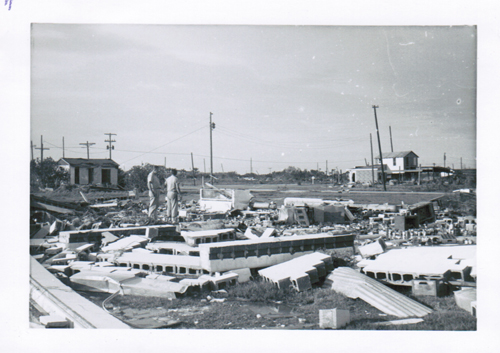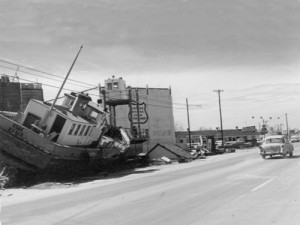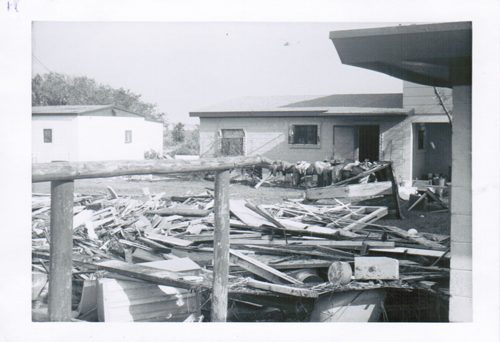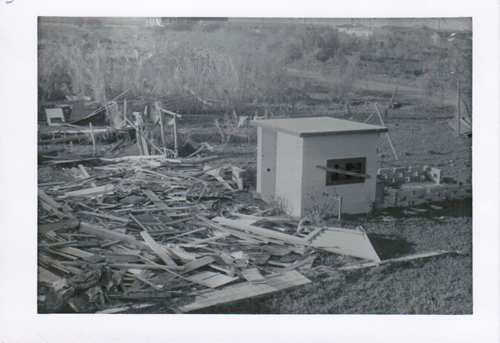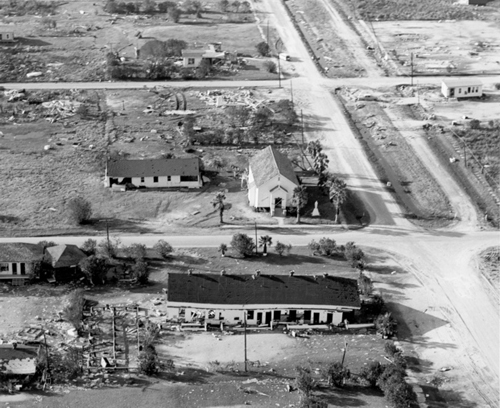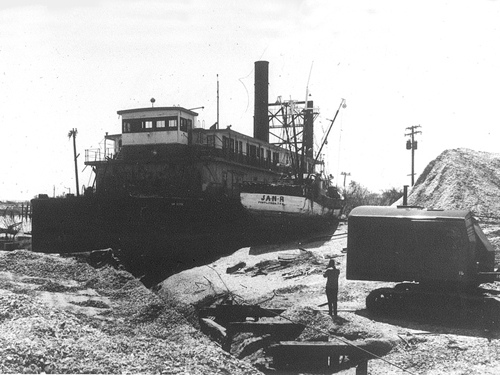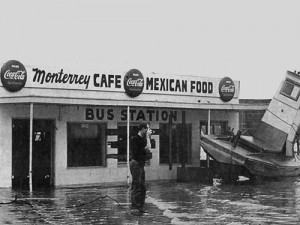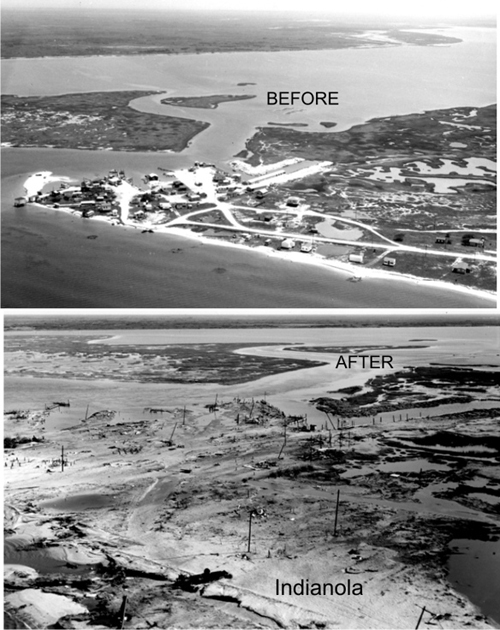A common sight in Port O’Connor after Hurricane Carla
-Photo contributed by Clarence and Naomi Albrecht.
It has been 50 years since Hurricane Carla struck the Texas Coast on September 11, 1961. Carla killed 43 people, 31 of them in Texas. The low death toll is credited to what was then the largest peacetime evacuation in US history. Storm surge was measured at 22 feet near the heads of the bays, in some places penetrating 10 miles inland. Because of its large size, the entire Texas coast was affected, and damage was reported as far inland as Dallas. Sustained winds were reported to be 115 mph in Matagorda. Wind gusts as high as 170 mph were recorded in Port Lavaca.
This storm marked the first live television broadcast of a hurricane. Owing to the intensity of and destruction by the storm, the name Carla was retired, and will never again be used for an Atlantic hurricane.
Dolphin Talk is pleased to print the following recollections of Hurricane Carla and its aftermath, submitted by Janice Albrecht Stalder of Port O’Connor, who now resides in Copperas Cove and Russell Cain and Jan Regan of Port Lavaca.
Memories of Carla By Russell Cain
Our family was one of the last ones to travel across the two lane causeway between Port Lavaca and Point Comfort. We were proud to live in Point Comfort. My brother Alan and two sisters, Sharon & Barbara all learned how to swim in the city swimming pool and we also enjoyed fishing at the Point Comfort pier earlier that summer.
During the hurricane we stayed in a motel in San Antonio and the tornadoes were running wild. It took the roof off the two story hotel where we were.
A lot of the Alcoa people were worried about their homes and animals. Coming back it was hard to get into the area. I remember all the dead cattle all over the Highways between Port Lavaca and Point Comfort. A tornado hit the Mayor’s (Scott Vaughn) home on Texas Avenue in Point Comfort. The shrimp boats were up on Main Street in Port Lavaca and up on Hwy 316 near King Fisher and Magnolia Beach. Doc Roemer’s pots and pans were found over at Chocolate Bay with his name on the bottom of the pots. Doc told me that he and Joy ( his wife) were sitting in their den and heard a noise in the flower box in the house – a month later and there was a huge rattle snake.
There was 4’ of water over the bluff on Villa Road and South Virginia St. during Carla. Dr. York Lancaster’s house had the framing of their new home up. We did not have electricity for awhile and had to boil water.
We did not know if we were even going to have a home to return to. Many people stayed at the Courthouse, Bauer Dredge and Leonard Fisher’s warehouse. What a time in Calhoun County!
Carla Recalled By Janice Albrecht Stalder
On the Labor Day weekend in 1961 I had just returned from swimming in the canal with my cousin, Sydney Claire Albrecht, when my parents, Clarence and Naomi Albrecht, told me to start packing. A hurricane was headed in our direction; we needed to evacuate.
Some might choose to try to ride out the storm, but Clarence Albrecht grew up in Port O’Connor and knew the power of waves and wind: he would take his family to safety.
We threw clothing into suitcases and precious items into boxes, piled our station wagon and boat with all we could fit into it, hitched the boat trailer to the station wagon, and headed inland. Many of those next few days are vague to me now, but I remember listening to the radio on Sept 11, 1961, at my grandparents’ home in Lampasas county, only a few miles from where I now live and teach, and realizing that Hurricane Carla had slammed into Port O’Connor.
What that really meant I didn’t understand then, but I began to have some idea a few days later when we headed home and saw missing roofs and badly damaged buildings in Austin, over two hundred miles inland. Stopping at my Uncle Olin’s house in Victoria, we were relieved when we heard that planes flying over Port O’Connor had spotted our house still standing.
What we still didn’t understand was how much damage six feet of water and 170-mile-per-hour winds can do to a concrete block house even if it is “still standing.”
Driving from Victoria to Port O’Connor was like descending into hell. We saw broken telephone and electricity poles, dead cattle piled up against fence lines and barges stranded in the middle of pastures. A mile outside of town I spotted our platform rocker hanging from a barbed wire fence.
Yes, the house was still there – minus doors and windows and filled with mud and dead jellyfish.
Pieces of other people’s homes and a massive tree trunk were piled five or six feet high in our back yard. A roof that clearly had flown through the air at some point had ended up against the outside wall of a bedroom. Our couch was on the back porch on top of the sliding glass doors, the refrigerator was in the back yard, and later we would find our freezer several blocks away. A friend would find our butane tank in the middle of a pasture outside town.
Of course, one of the first things I did was step on a nail, thus forcing my nearly overwhelmed parents to take me out of town to find a doctor and a tetanus shot.
My mother remained calm, if tight-lipped, as she reached up for a glass bowl that had been placed just above the high water mark and had miraculously survived the storm. She sat it on the drainboard and opened the dish cabinet above it – and a pile of broken dishes churned around in the cabinet by the rising waters fell out and broke the one surviving bowl.
That’s when she finally sat down in the middle of the kitchen floor and cried.
But I don’t think that it ever occurred to us not to stay in our home and begin cleaning up. My father purchased a gasoline engine to put over the well pump, and we had water to begin the cleanup process. We brought in an old washpot in which to heat the water (we had plenty of scrap wood to burn!) and borrowed a camp stove on which to cook . My parents’ upstairs bedroom had its windows broken out and pieces of glass piercing its sheetrock walls, but it was less of a disaster zone than the rest of the house. We would live there while we cleaned up the rest of our property.
Of course, it would be months before we would have electricity again, so in effect we were living as my grandparents had at the start of the 20th century. My parents remembered parts of that way of life, and I adjusted. We did the best we could with what we had.
And how we blessed the Salvation Army! Their mobile kitchen had arrived in town almost as quickly as we had and at once started serving hot meals. Nothing before or since has ever tasted so good.
The schoolhouse, refuge during the storm to the few people who stayed in town and survived the storm, now became a site for the Red Cross to unload truckloads of clothing and furniture. My mother, principal of the school, and teachers worked with them. At some point my father went back to work at the plant and I started the ninth grade at what was then Travis Junior High School in Port Lavaca.
We moved one of the Red Cross mattresses upstairs, put it on the floor behind two chests, and created me a semi-private bedroom area. Every day I took the bus to and from a different world, that of school, before returning home to do homework by a floundering lantern and try to help in the cleanup. (I doubt that I really was much help!)
I will never forget the smell of burning cattle along the road to Port Lavaca as the Corps of Engineers bulldozed up great piles of dead animals, covered them with chemicals, and set them afire.
I remember also the cattle and horses wandering about town for weeks, many of them far from the ranches – including Matagorda Island – from which they came and some of them badly cut up and injured by debris and wire fences. I kept trying to catch the worst injured horses and pour peroxide on infected wounds.
I remember also the day the Corps of Engineers brought in a crane to pick up the giant tree trunk lying in our backyard and lift it out over the top of our house.
Of course, I was too young fully to appreciate the challenges facing my parents and other adults struggling to recover lives smashed out of recognition.
But I was not too young to notice something else. I saw the men and women from church and civic groups who came from all over to help us clean up our town. I heard my parents talking about the farmers in another state who mortgaged crops in the field so that they could send funds to help Port O’Connor rebuild. I saw the shipment of little pine trees sent to our town to replace trees destroyed by the hurricane.
I smiled as I drank pure spring water from what appeared to be a beer bottle, Two Texas breweries had shut down their beer production long enough to bottle water to ship to us in days before bottled water was easily available and when our own wells were too polluted for drinking.
I observed as the adults around me went back to their day jobs to earn badly needed salaries but continued to work until exhaustion to bring our town back to life.
I saw men and women with nothing work to rebuild something.
A few years later, when I was a senior in high school, I would write an essay about having seen the true Spirit of America that year. In the 50 years since Hurricane Carla forever changed Port O’Connor, I have seen nothing to make me change my mind.
On another 9/11 a few years ago, when I watched in shock as two great towers came down and felt pride when I heard of the heroism of men and women who struggled to survive that disaster, I was reminded again of that Spirit of America. As I read of construction workers in Manhattan who left their jobs to plunge into danger in hopes of helping the first responders who already had entered the damaged towers, I remembered those who came to Port O’Connor in 1961. When I read of restaurant owners who emptied their freezers to take food to the refugees of that man-made disaster, I remembered the volunteers with the Salvation Army.
True heroes are not actors on television screens or athletes in sports stadiums; they are the men and women of America who deal with whatever nature or unnatural men throw at them and fight to keep this nation not only building but, when necessary, rebuilding.
I learned that lesson in Port O’Connor in 1961.
Carla and the Jan R By Jan Regan
My dad Woody Regan and Jimmy Wallace had a 72’ shrimp boat named the Jan R, after me. It was the largest shrimp boat on the Texas coast and could stay out in the Gulf of Mexico two weeks because of the amount of ice it could hold.
Dad decided that a safe place for his one shrimp boat during Carla was tied to the leeward side of Bauer Dredging Co.’s huge dredge that had spuds that could go 20 feet into the bay bottom.
Little did he know that Carla was pushing a 20’ storm surge by the time she hit Port Lavaca. Hence, the picture of the Jan R and the dredge sitting on top of the pile of oyster shells behind the dredging company.
Oh, well. There went the funds for my college education.
